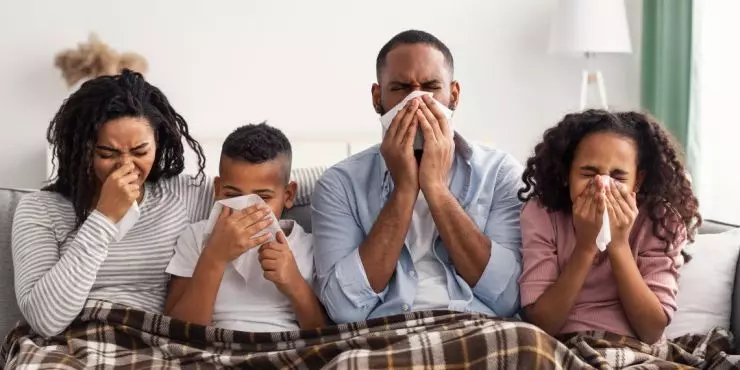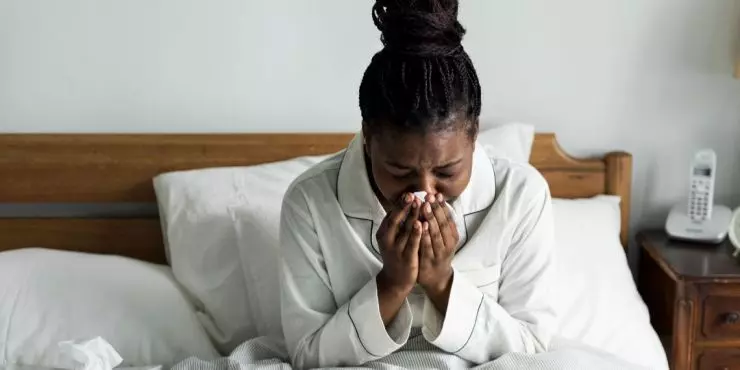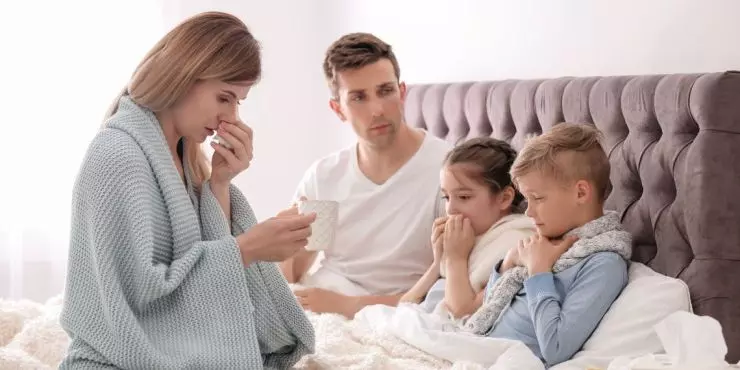
Whether it’s a runny nose brought home from preschool, a cough that shows up after work, or a stomach bug that spreads faster than you can sanitize—illness in one family member can quickly affect everyone under the same roof.
We know how challenging it is to keep the rest of the household well, especially in the fall and winter months when viruses like the flu, RSV, COVID-19, and the common cold become more widespread in Minnesota. The good news? With a few simple strategies, it’s possible to limit the spread and protect the rest of your family.
Here’s what works—and what’s worth focusing on.
Start With the Basics: Handwashing and Hygiene

Handwashing is still one of the best ways to stop the spread of germs. Teach kids to wash hands thoroughly with soap and warm water for at least 20 seconds—especially before meals, after coughing or sneezing, and after using the bathroom.
5 Simple steps to proper handwashing:
- Turn on faucet with warm water, rinse hands, and turn off the tap
- Lather hands with soap (about a tablespoon), scrubbing in between fingers, the backs of the hands, and under fingernails and don’t forget your thumbs!
- Scrub hands for approximately 20 seconds - think of singing Happy Birthday twice
- Turn the faucet back on with warm water and rinse hands
- Dry hands thoroughly with an air dryer or clean dry paper towel and use a paper towel to turn off the faucet
Other helpful habits:
- Use tissues (or elbows) to cover sneezes and coughs
- Dispose of used tissues promptly
- Avoid touching your face—especially eyes, nose, and mouth
- Wear a mask
Keep hand sanitizer in high-traffic areas like entryways, kitchens, and bedrooms for quick clean-ups, but remember proper handwashing is always best.
Designate a “Sick Zone”

If possible, have the sick person stay in one area of the house—like a bedroom or designated couch. This can reduce the number of shared surfaces and help everyone else maintain distance.
For kids, this might mean setting up a cozy “rest nest” with favorite books, quiet toys, or a tablet. Make it a positive space so they don’t feel isolated, but try to keep them separated from siblings when symptoms are active.
Disinfect High-Touch Surfaces
Focus your cleaning energy where it counts:
- Doorknobs and light switches
- Faucet handles
- Remote controls
- Phones and tablets
- Fridge and microwave handles
- Shared bathroom surfaces
Use hydrogen peroxide, 70% isopropyl alcohol, disinfecting wipes or a diluted bleach solution (1 tablespoon of bleach to 1 quart of water) and let the surface air dry.
Keep the Air Fresh
Minnesota winters can make it tempting to seal up the house, but stagnant air helps germs linger. Open windows for 10–15 minutes a day when weather allows, or run an air purifier with a HEPA filter to reduce airborne particles.
Don’t Share Personal Items
Even the most generous kids should learn to avoid sharing the following when someone’s sick:
- Water bottles and cups
- Utensils and food
- Toothbrushes
- Towels and washcloths
- Pillows or stuffed animals (especially between siblings)
Prioritize Sleep and Nutrition
Getting enough rest and eating well can strengthen the immune system and help the body fight off germs before they take hold.
Try to:
- Keep bedtime routines consistent
- Offer immune-supporting foods like citrus fruits, leafy greens, unsweetened yogurt, and lean proteins
- Encourage hydration with water, herbal teas, or warm broths
Mask Up When Needed
Masks aren’t just for pandemics—they’re a useful tool anytime someone in your home has a respiratory illness. If the sick person is coughing, sneezing, or has a fever, wearing a well-fitting mask (like a surgical or KN95) can help protect others in shared spaces. This is especially important if someone in your household is at higher risk, such as an infant, a grandparent, or someone with a weakened immune system.
Likewise, if a healthy person needs to care for someone who's sick—helping with meals, medications, or cleanup—it’s a good idea for the caregiver to wear a mask, too. It’s a small step that can make a big difference in stopping germs from spreading.
In tight quarters, like many Minnesota homes during winter, masking can add an extra layer of protection until symptoms improve or the person is fever-free for at least 24 hours.
Know When to Call the Doctor
Call your provider if:
- Symptoms worsen or last longer than expected
- A high fever (102.5 degrees F or higher) doesn’t respond to medication
- You’re unsure if it’s contagious
- Someone in the house is at higher risk of complications (such as infants, elderly, or immunocompromised individuals)
At Northwest Family Clinics, we offer same-day and urgent care appointments, so you’re not left guessing. Our locations in Crystal, Rogers, and Plymouth are here when you need us.
Minnesota-Specific Advice
During fall and winter, Minnesota schools and daycare centers often experience spikes in cold, flu, and RSV. If your child has been exposed, monitor for symptoms for 3–5 days. When in doubt, reach out to your provider for guidance—we're just a short drive away in the northwest suburbs of the Twin Cities.
FAQs: Managing Illness in the Home

Q: Should I keep my child home if a sibling is sick?
A: Not always. If your other child is symptom-free and feels well, it’s usually okay to send them to school. Let your provider know if you’re unsure.
Q: How long should we wait before returning to shared bedrooms?
A: Once the sick person is fever-free for 24 hours without medication and symptoms are improving, it's generally safe to resume normal routines.
Q: Should everyone in the house take immune-boosting supplements?
A: It's best to talk to your doctor. A well-balanced diet and good hydration is usually enough, but vitamin D, C, and zinc may be recommended during the winter months in Minnesota.
You’re Doing Great
It’s not always possible to prevent every sniffle or sore throat—but by taking a few proactive steps, you can limit the spread and support everyone’s recovery. As your local, physician-owned clinic, Northwest Family Clinics is here for the messy, sniffly, sleep-deprived parts of family life too.
Need to check symptoms, schedule a visit, or just ask a question? Call or schedule online at one of our three locations—Crystal, Rogers, or Plymouth. We’re here for your family, every step of the way.